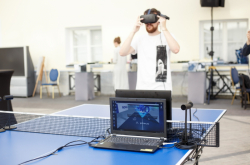Puzzle: The Southward Stream
Storyline. Inspired by the worlds of Hayao Miyazaki and H.P. Lovecraft, the story is set in an alternative WWI-era Europe. The protagonist discovers a bottle washed up on the ocean shore with a submarine officer’s journal inside – and embarks on a poignant journey through the vessel's ill-fated voyage.
Behind the scenes. The game is produced by a team of 10 developers – scriptwriters, game designers, programmers, and artists – who have already finished the prototype and plan to release the game by the end of the year.
In The Southward Stream, the developers successfully implemented a parallax scrolling effect, which is a common feature in side-scrollers. The effect is based on making different objects, background textures, and other graphic elements move at different speeds in relation to the player, giving off an illusion of depth in a 2D game. The developers achieved the somber atmosphere with a tailored-made light module that lets 2D objects cast shadows in a 3D world
“Like other gamedev students, I was itching to make games but had no idea how to. So when we received an assignment to design a game last year, I saw that as a chance to finally get started. Thanks to ITMO, we built our first project and tried our hands at gamedev. Moreover, we also trained our teamwork skills, which are a must for the industry,” shares Nikita Yastrebov, a developer of The Southward Stream and student of ITMO’s Game Development Technologies Master’s program.
Roguelike shooter: Hell over Me
Storyline. Hell over Me is a first-person shooter in which the player’s death has dire consequences: if your character is killed, you will have to start over again – and on a different map. Hell over Me takes players to the new Earth after Judgment Day, where they will have to make their way through all nine circles of Hell to be redeemed. Their only helper in this journey is a mysterious hand that will guide them along the way. To get to the end, the players will have to fight enemies, collect weapons, and upgrade their character.
Behind the scenes. The development team consists of eight people: a game designer, programmers, a 3D specialist, a VFX designer, and sound designers. The game is currently in development, but a demo version is available here.
Instead of using third-party assets, the developers do all the work themselves, starting from code to models, textures, and music. For the game, the team used the Gameplay Ability System (GAS), which makes it possible to set up all in-game events and tie them to the traits of both the player and the enemies. With this system, the team can customize the various features, effects, mutual synergy, and triggers – and thus create tens and hundreds of one-of-a-kind upgrades.
The game features a procedurally generated world – and that includes not only the floating islands and arenas visited by the player, but even the weapons and enemies. As for the soundscape, the game employs the FMOD and Wwise sound engines, paired with Unreal Engine 5’s MetaSounds.
“At ITMO, we are surrounded by like-minded people who are just as passionate about gamedev as we are. That helps us avoid burnout, fight procrastination, and meet all the deadlines. Better still, the knowledge and skills we acquired at the university pave the way for career successes. Two of our team members have already landed a job in the field. In my case, my computer graphics expertise served me well when I was interviewing for my current position. What also helped was a games showcase that we had in our first semester,” says Daniil Rukosuev, a developer of Hell over Me and student of ITMO’s Game Development Technologies Master’s program.
City-building game: Magistry
Storyline. Taking inspiration from Factorio, Magistry calls on players to build a city and protect it from golems once darkness falls. Apart from city-builders, the game also shares some elements with automation games, namely mining and processing facilities, pipelines, splitters, and manipulators. The world of Magistry is a grid of hexagonal cells where players can erect objects only within the radius of a crystal – the city’s main power source. This energy is necessary to construct buildings, but players need to calculate their moves carefully, as the resource is not endless.
Behind the scenes. The team consists of four people: a 2D/3D designer, two C++ programmers, a game designer, and the team leader. Though it is still in the prototype stage, you can test the game and give your feedback here.
What makes this game unique are the custom-built mechanics. The hexagonal grid, PCG algorithms, as well as all the models, textures, animations, and sounds – all these were created by the developers from scratch.
“The program helped us in several ways. First of all, we had to design a game as our term project within a limited time. Having a tight deadline helped us be more organized and consistent with our work. What’s more, we already had classes on Unreal Engine 5 in our first semester, so we didn't need to spend any time trying to figure it out,” notes Alexander Denisov, a developer of Magistry and student of ITMO’s Game Development Technologies Master’s program.





